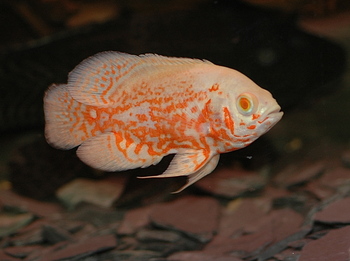If you’ve ever owned or even just observed an oscar fish, you already know they’re not your typical aquarium residents. These vibrant, intelligent cichlids from South America are full of attitude and personality. Oscars don’t just swim — they interact. They learn feeding routines, recognize their owners, and sometimes even sulk when ignored.
But what makes oscars truly fascinating is the incredible variety of breeds available today. Each type brings a unique combination of color, pattern, and flair, from the fiery reds of the Super Red Oscar to the elegant whites of the Albino Oscar. Thanks to years of selective breeding, aquarium hobbyists can now choose from several beautiful variations — each with its own charm and appeal.
Let’s dive deeper into the most well-known oscar fish breeds, what makes them stand out, and how to choose the perfect one for your aquarium.

1. Tiger Oscar (Astronotus ocellatus var. Tiger)
The Tiger Oscar is the classic variety — bold, colorful, and brimming with energy. Its striking orange-red patterns stretch across a dark black body, resembling tiger stripes. This pattern gives it a wild, untamed look that many aquarists adore.
Tiger Oscars are often playful and can be trained to recognize feeding cues or even take food directly from your hand. Their markings become richer as they mature, especially when fed a diet high in carotenoids (found in shrimp, krill, and quality cichlid pellets).
They can grow up to 12 inches and need plenty of swimming space. A single adult should ideally have at least a 75-gallon tank with good filtration, since Oscars are known to be messy eaters.
Fun fact: Many aquarists notice that Tiger Oscars slightly change their coloration based on mood, health, and even social interactions with other fish.
2. Albino Oscar
The Albino Oscar is instantly recognizable with its milky white or pinkish body and bright red eyes. Its appearance is the result of a lack of dark pigmentation, but it still retains the same personality and intelligence as any other oscar.
Albino Oscars often show faint orange or golden hues across their body, especially along the dorsal area or fins. Under gentle aquarium lighting, they almost appear to glow.
They prefer moderate lighting — bright lights can stress them or cause them to fade slightly. Because of their pale coloring, scratches or injuries are more visible, so smooth decorations and fine substrates like sand are best.
These Oscars are a wonderful choice for those who want something different yet equally interactive and lively.
Care tip: Because of their lighter skin tone, Albino Oscars are slightly more sensitive to bright lighting. Moderate or diffused aquarium lights help them feel more comfortable.
3. Red Oscar
If you’re drawn to bold, vivid colors, the Red Oscar is impossible to overlook. This breed showcases deep orange to bright red shades, often covering most of the body. Some individuals, known as Super Red Oscars, display an almost solid red hue that seems to glow under tank lights.
Their color intensity depends heavily on genetics and diet. Owners often notice deeper reds after feeding color-enhancing foods rich in astaxanthin, such as shrimp or bloodworms.
Red Oscars are known to be slightly more assertive, though their behavior largely depends on the individual fish and environment. With consistent care and stable water parameters, their color remains one of the most stunning sights in any aquarium.
Aquarist insight: The depth of red coloration can fade if the fish isn’t fed properly. A diet that includes high-quality pellets and natural color enhancers like shrimp or krill helps maintain that signature glow.
4. Copper Oscar
The Copper Oscar is a rarer variety that shimmers with a metallic copper or bronze sheen. Its body may display subtle blends of orange, red, and brown tones, creating a warm, reflective glow.
This unique coloration makes the Copper Oscar a favorite among collectors and experienced aquarists who want something different from the usual patterns. When viewed under aquarium lights, they appear almost iridescent, shifting between gold and bronze as they move.
They have the same care requirements as other Oscars but often look best in tanks with darker substrates and backgrounds, which help emphasize their metallic glow.
Fun fact: In certain lighting, Copper Oscars almost look iridescent, giving them a three-dimensional glow that stands out even in a large aquarium.
5. Lemon Oscar
The Lemon Oscar is a bright, cheerful variety with a yellow to golden body and gentle undertones of cream or white. Unlike Albinos, they have normal eye coloration and a soft, buttery look that makes them stand out without being overwhelming.
This color variation is a result of xanthistic genetics, meaning it produces yellow pigmentation instead of the usual reds and blacks. Lemon Oscars are relatively uncommon and prized for their gentle yet vibrant appearance.
Owners say these fish are calm and observant, often spending time exploring or rearranging decorations. Their yellow hue stands out beautifully against dark gravel or backgrounds, creating a striking contrast.
Owner note: Lemon Oscars tend to look best in aquariums with dark backgrounds, which help their yellow tones pop beautifully.
6. Long-Finned Oscar
The Long-Finned Oscar, also known as the Veil Tail Oscar, is one of the most elegant breeds. These fish possess elongated, flowing fins that trail behind them as they swim, adding an extra layer of grace and beauty.
Long-finned varieties are available in several color types — including Tiger, Albino, and Red. They need a bit more care because their fins can tear easily if the tank has rough décor or aggressive tank mates.
Their slow, fluid movements make them appear calm and regal, often becoming the centerpiece of large aquariums.
Aquarist tip: Keep the water clean and well-filtered to prevent fin damage. The long fins are delicate and prone to tearing if water conditions aren’t optimal.
Other Recognized Varieties
While the six above are the most well-known, a few other names and forms are worth mentioning:
- Velvet Cichlid: An older name for the wild-type Oscar, featuring darker, earthier tones with subtle orange spots.
- Marble Cichlid: A trade name sometimes used for Oscars with mixed or irregular color patterns.
- Super Red Oscar: A selectively bred, bright-red strain that takes the Red Oscar’s coloration to another level.
- Leucistic Oscar: Similar to Albino, but genetically distinct—these fish are mostly white without the red eyes.
Color Maintenance and Health Tips
Oscars are known for their changing colors — they can darken, fade, or intensify depending on health, diet, and stress levels. To keep their hues vibrant:
- Feed a color-rich diet: Include foods like shrimp, krill, and pellets with natural carotenoids.
- Maintain clean water: Poor water quality can dull their color and reduce activity.
- Use proper lighting: Balanced LED lighting enhances their appearance without stressing them.
- Avoid overcrowding: Too many tank mates can cause territorial stress, leading to color fading.
When Oscars are healthy, happy, and well-fed, their colors truly come to life — especially during feeding or mating behavior, when they often become brighter and more expressive.
Personality and Behavior Across Breeds
No matter the breed, every oscar fish shares a few defining traits: intelligence, curiosity, and a strong personality. These fish are known for recognizing their owners, following fingers along the glass, and even “begging” at feeding times.
They’re territorial but not necessarily aggressive if given enough space. Some owners even report Oscars allowing gentle touches on the tank glass or playing with floating toys.
Oscars are best kept alone or with equally large, peaceful species like silver dollars, large plecos, or severum cichlids. Small fish should be avoided — Oscars will almost certainly view them as food.
Choosing the Right Oscar for Your Aquarium
When choosing an oscar breed, it’s not just about color—it’s also about compatibility, personality, and tank setup. All oscar varieties share the same species characteristics, meaning they grow large, produce a fair amount of waste, and require good filtration and spacious tanks.
Here’s a quick care summary for all oscar breeds:
- Tank size: At least 75 gallons per adult.
- Water temperature: 74–81°F (23–27°C).
- Diet: High-quality cichlid pellets, live or frozen foods like shrimp and worms, and occasional veggies.
- Behavior: Territorial, intelligent, and highly interactive.
- Companions: Large, peaceful fish like silver dollars or plecos; avoid smaller tank mates that could be mistaken for food.
Oscars are often described as “aquarium dogs” because of how they interact with people. Regardless of the breed you choose, you’re getting a fish that’s both beautiful and full of personality.

Frequently Asked Questions (FAQs)
1. What is the most popular oscar fish breed?
The Tiger Oscar is the most popular due to its vibrant orange-and-black markings and widespread availability.
2. How big do oscar fish get?
Most Oscars grow up to 12 inches (30 cm) long, though some can reach 14 inches in large tanks with proper care.
3. Are different oscar breeds compatible with each other?
Yes, most oscar breeds can live together as long as the tank is large enough (at least 125 gallons for two adults) and each fish has enough space to establish territory.
4. Do all oscar fish have the same temperament?
Generally, yes. All varieties share the same intelligent and territorial nature, though individual personalities can vary.
5. What’s the rarest oscar fish variety?
The Lemon Oscar and Copper Oscar are considered among the rarer types due to limited breeding and availability.
6. How can I enhance my oscar’s color?
Feed a balanced diet rich in natural pigments, like shrimp or krill, and maintain clean water and good lighting to keep their colors bright.
7. Are Oscars aggressive?
They can be territorial, especially during feeding or breeding, but they’re not naturally aggressive if kept properly.
8. How long do Oscars live?
With good care and water maintenance, Oscars typically live 10–15 years, sometimes even longer.
Final Thoughts
From the dramatic Tiger Oscar to the radiant Super Red and graceful Long-Finned, each oscar fish breed brings its own beauty and personality to the aquarium. These fish are more than just colorful pets — they’re interactive companions that can form real bonds with their owners.
Whichever variety you choose, remember that Oscars thrive on attention, good food, and clean water. Provide those essentials, and your Oscar will reward you with years of lively color, curiosity, and charm.
Owning an oscar isn’t just about keeping a fish — it’s about building a relationship with one of the most intelligent and expressive freshwater species in the aquarium world.






